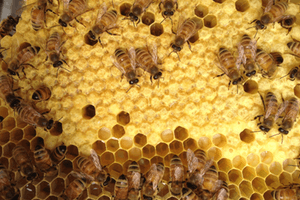- All-In-One Beekeeping for the Bees
- +1-608-728-8233
- info@beepods.com
Coevolution: Bees and Flowers

Ophrys apifera, known in Europe as the bee orchid, is an example of a highly-evolved plant-pollinator relationship.
Bees and flowers. Predators and prey. Hosts and parasites. These are just a few examples of species that have coevolved, living together so intimately for so long that they have influenced each other’s evolution. In a classroom, we can relate coevolution to teachers adjusting their lesson plans based on the personalities in a particular class. We might also think of students who behave differently in different classes based on each teacher’s personality and expectations.

The honey badger coevolved with bees. Photo: Derek Keats, Wikimedia
If you have high school students, you can hook their interest in coevolution by connecting to the viral honey badger YouTube video from 2011. (Warning: Contains mature language.) The honey badger coevolved with the African honey bee. The honey badger loves honey. African bees dislike intruders. The honey badger evolved to develop long claws to tear into hives and thick skin that can withstand numerous stings. The African bees in turn evolved to secrete a pheromone when they are dying so other bees continue to attack.

Ophrys apifera, known in Europe as the bee orchid, is an example of coevolution in a plant-pollinator relationship. Photo: needpix.com
Speaking of pheromones, orchids across Europe, Africa, South America, and Australia emit pheromones that are similar to the sex pheromones secreted by bees and wasps. The male insects smell the female scent and attempt to mate with the flower. In the process, they pick up pollen which they then deliver to the next orchid. The flowers evolved this ability at the same time that the insects were evolving.

The hammer orchid uses mimicry to attract male wasps.
A specific example of this involves the Australian hammer orchid and the thynnid wasp. The wasp’s mating ritual involves a female sitting atop a branch or plant, waiting for a male to spot her. The hammer orchid mimics the female wasp’s shiny head and furry body, creating an upward-gazing pose. But what happens if a real female wasp shows up? Natural selection took care of that, too. These orchids only bloom when the males are out flying, but the females are not out yet.
Once you have students’ attention, have them focus on the coevolution of bees and flowers. Many flowers, for example, have adopted colors in the middle of the visual range of bees. Thor Hanson, biologist and author of the book Buzz: The Nature and Necessity of Bees, says that much of what we see in nature is influenced by bees. Ask for a show of hands to see how many students like the look and smell of flowers. Then ask how many like the look and smell of rotten meat. Without bees, Hanson explains, flowers would be more likely to coevolve with wasps and flies who are attracted to musky and rotten flesh smells.

Snapdragons are commonly pollinated by bumblebees because they are large enough to open the flower. Photo: pikist.com
Another example is the snapdragon flower. The snapdragon only wants to attract bumblebees, so it releases four times more scent during the day, when bumblebees are active, than at night. Bumblebees are just the right weight to trip the opening mechanism allowing access to nectar.
When you look for online resources on coevolution, the material gets pretty lofty for younger students. eSchoolToday has a child-friendly lesson on honey bees’ coevolution that won’t scare them off. It likens coevolution to being close friends for a long time. Did you know that flowers need to have a landing pad because bees stand when they eat nectar? We also learn that bees developed hairs on their bodies and legs designed to collect pollen.
Flowers and bees have coevolved in ways that many of us don’t even realize. Support this relationship by starting a pollinator garden at your school or adding a Beepods Education System to your campus. Your students will see the magic of bees and flowers living in harmony.
Resources:
https://www.ndsu.edu/pubweb/chiwonlee/plsc211/student%20papers/articles02/mreinicke/mreinicke.html
https://www.softschools.com/examples/grammar/coevolution_examples/649/
Bill Polacheck
Latest posts by Bill Polacheck (see all)
- Level Up with a Beekeeping Course - September 15, 2020
- Beepods Harvest Box: Helping Your Bees Survive the Winter - September 8, 2020
- Simple Ways You Can Communicate Like a Bee - September 1, 2020



